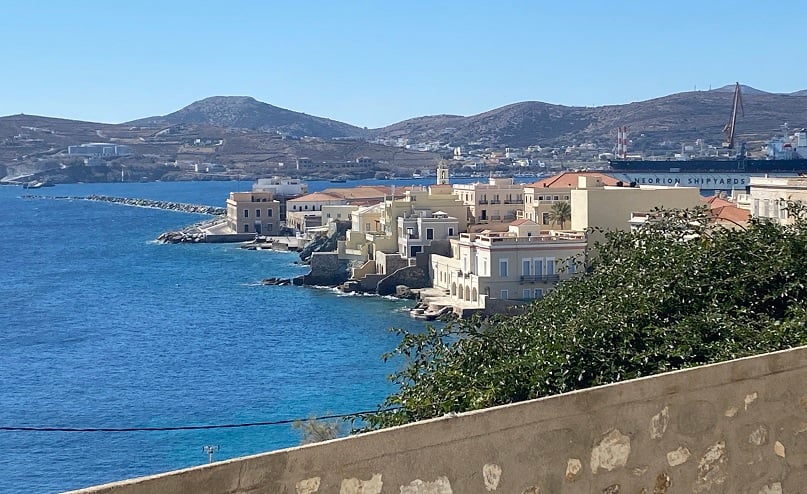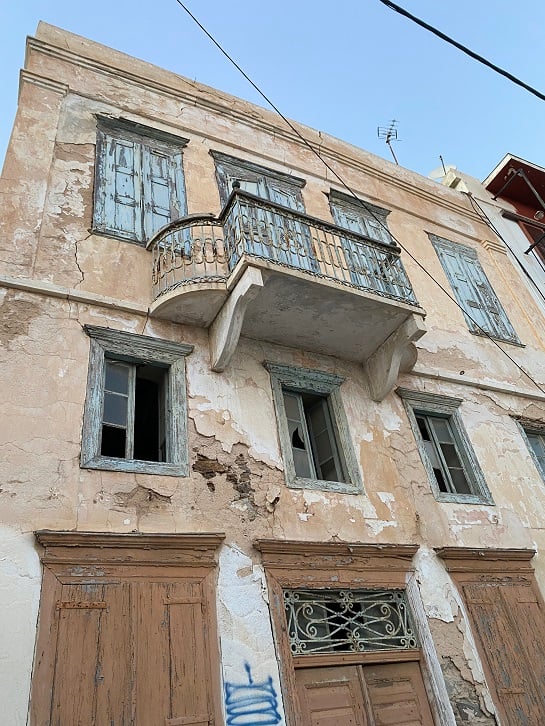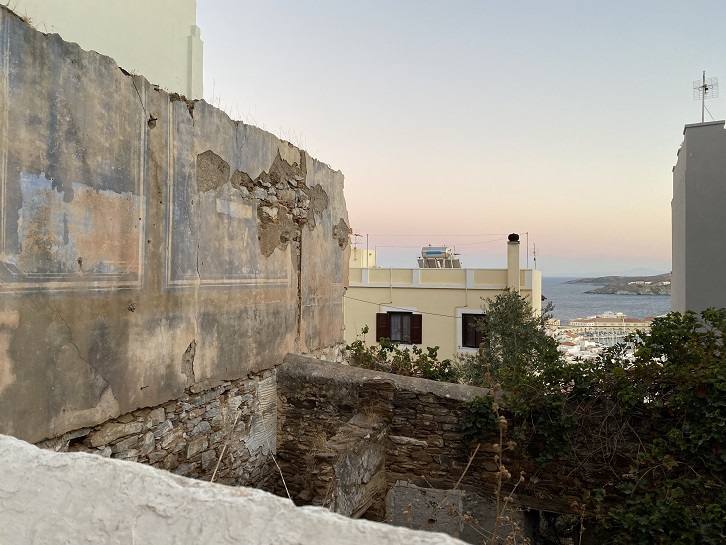
Syros neoclassical buildings are in imminent danger of ruination, as a result of chronically unsuccessful preservation policies.
Lengthy bureaucratic procedures and the lack of restoration funding incentives are posing a threat to over a thousand decaying, privately-owned neoclassical listed buildings on the Greek island of Syros, according to residents.
Majestic mansion houses of unique artistry and beauty; edifices of utmost historical significance; and a former Europa Nostra Award winner, are among the buildings which have been abandoned at their fate for decades as state preservation policies fail to address the challenge.
Besides the cultural aspect and the damage caused to the unique architectural heritage of Syros, the risk of injury from falling materials is another important matter of concern.
Local campaigners and the Association of structural engineers of the Cyclades group of islands have been pleading to the Greek state for years to approve the implementation of specific, scientifically-backed solutions they propose.
Instead, any related measures adopted by the Ministry of Culture so far have proven slow and ineffective, they tell Greek Reporter.
The dramatic worsening of the situation was highlighted by the sudden collapse of one of the abandoned neoclassical buildings in question in February 2021, in the heart of Syros’s main town, Ermoupoli.
One year on from the incident, the locals’ request for faster restoration approval procedures, or at least some financial aid to owners, remain unanswered by the government.
Unique architectural identity of Syros
The grandiose neoclassical heritage of Syros is unique to the Cyclades group of islands, of which it is the administrative capital.
Although Syros’s architectural peculiarity is immediately noticeable by the visitor upon approaching the harbor, few people would know that the island was in fact the cradle of the famed Greek neoclassical architectural style, and the forerunner of the Athens neoclassicism.
Thanks to the special conditions prevailing on Syros during the Greek War of Independence (1821-1829), the island attracted refugees from other destroyed homelands in the Aegean Sea. It was them who built main town Ermoupoli, which flourished as the first commercial harbor of the newly founded Greek state in the 1830s, granting prosperity and prestige to the local bourgeoisie.
German architect Wilhelm von Weiler implemented the first street plan and established the monumental neoclassical architecture of Syros. Iconic buildings include the City Hall by Ernst Ziller and the Apollo Theatre by Pietro Campo -built as a miniature version of the La Scala theatre in Milano.
The pre-existing rural medieval village overlooking Ermoupoli from the hilltop, known as Ano Syros, is also remarkable, with its defensive architecture, circular layout and radial street plan.
Today, both Ano Syros and Ermoupoli are affected by the abandonment of many of their old buildings, estimated at one thousand in total.

Syros locals campaigning for solutions
United under a dedicated Facebook group, Syros locals have been striving to raise awareness on the dying off of the island’s architectural masterpieces since December 2020.
Their aim is to inform the public of the problem, the designated professional solutions proposed and their negotiation attempts with the government, as the matter has grown into a threat not only to the cultural heritage of the island, but also to the safety of residents and visitors, they argue.
“Beyond that one collapsed neoclassical building in February 2021, smaller pieces, like plaster and pediments, fall from other abandoned edifices almost on a daily basis, especially during the wet winter weather.
“If there was an earthquake like the ones we saw in Crete in autumn 2021, I can’t say how much of these buildings would have stayed standing”, says Harris Vekris, founder of the Save Syros Neoclassical Buildings campaign group.
Private owners, trusts, and aspiring investors are plagued by lengthy bureaucratic procedures and the lack of funding for restoration works on the listed edifices they have either inherited or wish to buy, he explains, and so the problem is perpetuated.
A restoration approval procedure takes a minimum 3-4 years for any listed building, during which time the project’s dossier goes back and forth to various councils, commissions, ministries and other public administration services, Vekris adds.
“These delays can discourage either Greeks or foreigners who might consider getting involved in renovating the properties with the prospect of moving in as a residence”, he notes.
But even in cases where the state has had to step in as an emergency to prevent imminent collapses of listed neoclassical buildings, the delays are of a similar extent.
Dangerous delays on Syros neoclassical buildings
A most typical example of the lengthy procedures for intervention approvals is that of the Cycladikon, a historical listed building facing the main square of Ermoupoli, across the street from Apollo theatre.
As documented by local media and council meetings, parts of the two-storey edifice collapsed in 2017.
Since the building’s owner trust was proven unable to cover any related costs, the Municipality of Ermoupoli stepped in to clean up the collapsed materials and initiate risk clearance work procedures on own expenses in 2018.
But the necessary works can only be green-lit by the Ministry of Culture, and, despite constant reminders from the Municipality, the former had not answered by February 2022, either to approve the proposed interventions or to indicate another suitable solution for risk clearance.
In the meantime, the Cycladikon remains cordoned-off, while the owner trust continues the quest for an investor to fund its total renovation -and to brave the bureaucracy involved.
Engineers’ action plan proposal rejected by ministry
“The whole issue is purely bureaucratic, it’s not insurmountable”, Vekris emphasizes.
“We do want the restoration works on Syros neoclassical buildings to be carried out properly -with their murals, ceiling paintings, and every other element restored in the way they should be- but a way must be found to accelerate procedures”, he insists.

The Association of structural engineers of the Cyclades has been long calling on the Ministry of Culture to approve the creation of an inter-ministerial body to operate as a “one-stop-shop” and fast-track the evaluation of restoration projects on the island to tackle the bureaucracy.
“That way, a works approval procedure that currently requires 3-4 years at best, could be complete in 3-4 months.
“Because any amendments requested by the various commissions could be immediately implemented and the dossier resubmitted in a month’s time, instead of waiting for all the remarks from each separate commission before one can amend and resubmit”, Vekris expounds.
Nonetheless, the Ministry of Culture dismissed the Cyclades engineers’ proposal as unconstitutional during a meeting with local stakeholders in December 2021, suggesting other solutions which the Engineers consider superficial.
Their Association has also downright rejected the unconstitutionality claim, asking the Ministry to prove it by legal documentation.
And so the discord continues, and the problem persists.
Syros neoclassical buildings popular with buyers
In the meantime, the interest for renovation and acquisition of Syros’ listed neoclassical buildings remains vivid both from within Greece and abroad.
Vekris advises that, to his knowledge, at least three neoclassical buildings were sold in 2021 to French owners.
“Foreign investors are clearly more affluent in making these acquisitions. But there are also Greeks who have inherited listed buildings on Syros and wish to keep them for residence.
“These owners should be aided too, not only with fast restoration works approvals, which should apply to everyone, but also financially. Otherwise, they will be forced to sell or let their buildings collapse. At the moment, all that the Greek owners gain from these buildings is the obligation to pay unified property tax (ENFIA)”, Vekris concludes.
See all the latest news from Greece and the world at Greekreporter.com. Contact our newsroom to report an update or send your story, photos and videos. Follow GR on Google News and subscribe here to our daily email!



